Corcovado
by
Philip Greenspun
Home : Travel : Costa Rica : One Part
Saturday, January 20, 1995
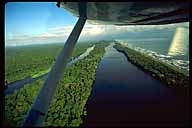 We flew out of Tortuguero in the morning in a Cessna 180 that looked
decidedly old and downmarket after the Piper Twin. The flight was beautiful
and this time I "checked" the yellow river that Edgar had mentioned. We also
saw the highway that we'd taken on the way back from rafting the Pacuare.
Costa Rica is one rugged country and the only way to fully appreciate it is
from the air. We changed planes in San Jose and picked up another
single-engine Cessna for the flight to Carate. We climbed away from the local
airport, over shantytowns and estates, then coffee plantations, and then
stripped hillsides with cabins. The Central Valley has many charms, but not
much wilderness remains.
We flew out of Tortuguero in the morning in a Cessna 180 that looked
decidedly old and downmarket after the Piper Twin. The flight was beautiful
and this time I "checked" the yellow river that Edgar had mentioned. We also
saw the highway that we'd taken on the way back from rafting the Pacuare.
Costa Rica is one rugged country and the only way to fully appreciate it is
from the air. We changed planes in San Jose and picked up another
single-engine Cessna for the flight to Carate. We climbed away from the local
airport, over shantytowns and estates, then coffee plantations, and then
stripped hillsides with cabins. The Central Valley has many charms, but not
much wilderness remains.
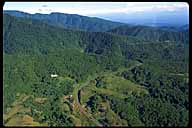 Once we were at 6500 feet cruising over the mountains, one could see some
primary forest broken up by ugly gashes. Each gash was a naked clearing with a
cabin, a dirt road that looked impassable, and a few felled trees left lying.
Once we were at 6500 feet cruising over the mountains, one could see some
primary forest broken up by ugly gashes. Each gash was a naked clearing with a
cabin, a dirt road that looked impassable, and a few felled trees left lying.
"It is an unfortunate part of the Costa Rican character that you aren't a man
unless you've cleared some rainforest," Bobby Coto had told us. This was quite
evident from the air.
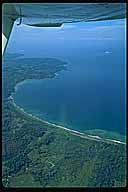
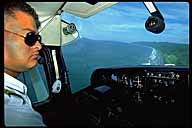 We followed the Pacific coast and the pilot pointed out Manuel Antonio National
Park, large oil palm plantations and then the Osa Peninsula, which was our
destination. When we touched down on the gravel airstrip at Carate, it
occurred to me that in 90 minutes of flying in a tiny Cessna, we'd gone from
the extreme northeast to the extreme southwest of the country. Costa Rica is
only about four times the size of Massachusetts and one fifth the size of
Colorado.
We followed the Pacific coast and the pilot pointed out Manuel Antonio National
Park, large oil palm plantations and then the Osa Peninsula, which was our
destination. When we touched down on the gravel airstrip at Carate, it
occurred to me that in 90 minutes of flying in a tiny Cessna, we'd gone from
the extreme northeast to the extreme southwest of the country. Costa Rica is
only about four times the size of Massachusetts and one fifth the size of
Colorado.
Check the map of Corcovado (95K)
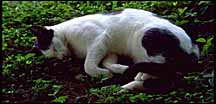 Downtown Carate proved to be a pulperia next to the airstrip. The
nearest telephone is in Puerto Jiménez, a 90 minute drive around the
coast over a dirt road.
Downtown Carate proved to be a pulperia next to the airstrip. The
nearest telephone is in Puerto Jiménez, a 90 minute drive around the
coast over a dirt road.
Urbano, a 45-year-old with a face that had been weathered in the hot dry sun of
Guanacaste, loaded our bags into a pony cart. Lana, a blonde from Colorado and
manager of the Corcovado Tent Camp, accompanied us down the beach past
shanties.
"There used to be real houses back in there," Lana explained. "Before this was
a park a lot of people were mining gold here."
A park ranger drove by in a jeep, right past a woman carrying a shovel.
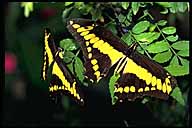 "You aren't supposed to drive on the beach," Lana said. "And you aren't
supposed to dig for gold anymore, but it happens. Anyway, the land back here
is owned by a rich Canadian. He didn't want these people living on his land.
On the other hand, there is a doctrine in Costa Rica that the first 25 meters
back from the beach are public property, so it wasn't really his land. Of
course, you aren't supposed to build a house on public land either, but these
people had been living there for more than seven years and there is another law
that says if you've been living somewhere for seven years then the land becomes
yours. There was a huge lawsuit."
"You aren't supposed to drive on the beach," Lana said. "And you aren't
supposed to dig for gold anymore, but it happens. Anyway, the land back here
is owned by a rich Canadian. He didn't want these people living on his land.
On the other hand, there is a doctrine in Costa Rica that the first 25 meters
back from the beach are public property, so it wasn't really his land. Of
course, you aren't supposed to build a house on public land either, but these
people had been living there for more than seven years and there is another law
that says if you've been living somewhere for seven years then the land becomes
yours. There was a huge lawsuit."
How did it all work out?
"I was coming up the beach one day and I saw hundreds of government troops with
rifles burning the houses," Lana answered. "Obviously the Canadian owner had
talked to the right people. It was a circus. I was taking pictures and one of
the guys with a gun came up to me and demanded my film. I argued with him for
awhile, but eventually handed it over. A guy who works in the lodge came
running through the woods and was taking pictures from the other side. He
stepped out of his sandals and was looking through the camera. He stepped back
into his sandals without looking and right onto a fer-de-lance [the most
aggressive and poisonous snake in Costa Rica]. I eventually got my film back a
few months later."
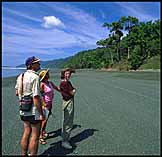
 The beach near Corcovado is lined with almond trees and these are much favored
by scarlet macaws, some of the most beautiful parrots in the world. We saw at
least 40 birds during the 45-minute walk to the tent camp. They were
invariably in pairs, flying side by side or feeding in impossibly twisted
orientations in the almond trees. I asked Lana about them.
The beach near Corcovado is lined with almond trees and these are much favored
by scarlet macaws, some of the most beautiful parrots in the world. We saw at
least 40 birds during the 45-minute walk to the tent camp. They were
invariably in pairs, flying side by side or feeding in impossibly twisted
orientations in the almond trees. I asked Lana about them.
"They live about 30 or 40 years and the adults have no predators," Lana
explained.
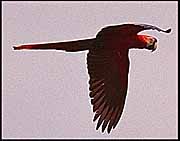 There are demonstrations for every conceivable cause practically every day in
Cambridge, Massachusetts. Rainforest preservation just seemed like yet another
entry in a long list of liberal grievances to me. Besides, it was tough to
imagine what I as an American could do about rainforests that were thousands of
miles away. Something kind of clicked (snapped?) in my brain, though, as I
watched the scarlet macaws.
There are demonstrations for every conceivable cause practically every day in
Cambridge, Massachusetts. Rainforest preservation just seemed like yet another
entry in a long list of liberal grievances to me. Besides, it was tough to
imagine what I as an American could do about rainforests that were thousands of
miles away. Something kind of clicked (snapped?) in my brain, though, as I
watched the scarlet macaws.
Parrots are as intelligent as dogs, but we don't share body language with them
as we do with dogs. ["They understand our language," Diane Ewing was later to
say to me, "but we don't understand theirs."] They form complex communities
and marriages between individuals that last decades. The abundance of parrots
in the New World was one of its most salient features to early European
explorers. In fact, a proposed name for the continents was "Land of
Parrots."
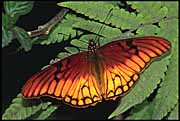 By the time we'd reached the tents, cutting down the parrots' habitat seemed to
me just as evil as going over to a neighborhood in Boston and burning all the
houses down. What right had we to destroy these communities of magnificent
lords of the forest?
By the time we'd reached the tents, cutting down the parrots' habitat seemed to
me just as evil as going over to a neighborhood in Boston and burning all the
houses down. What right had we to destroy these communities of magnificent
lords of the forest?
After we settled into our charming little tent, replete with flowers and clean
towels, we went for a swim in the warm Pacific. The surf was pounding, though,
and visibility poor. After the swim, we lunched with Jeffrey De Vito, a
Californian with a religious zeal for taking tourists up into the rainforest
canopy.
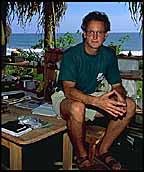 The rainforest canopy was pretty much ignored for the first few hundred years
of exploration. Somebody eventually got the brilliant idea that the most
action would logically be where there was the most light, i.e., up in the
canopy. One biologist intensively sprayed area of the canopy with insecticide
then counted all of the dead stuff that fell to the ground. Donald Perry was
among the first biologists to take a direct approach: actually go up into the
canopy and observe.
The rainforest canopy was pretty much ignored for the first few hundred years
of exploration. Somebody eventually got the brilliant idea that the most
action would logically be where there was the most light, i.e., up in the
canopy. One biologist intensively sprayed area of the canopy with insecticide
then counted all of the dead stuff that fell to the ground. Donald Perry was
among the first biologists to take a direct approach: actually go up into the
canopy and observe.
Jeffrey has built a platform in the canopy of some virgin rainforest
just behind the tent camp and adjacent to Corcovado National Park.
"All of our financing is private," Jeffrey noted. "Costa Rica is at a crucial
point right now. In the next few years it is going to be either developed into
another Hawaii or Cancun or developed with some sensitivity in a sustainable
manner. We have to show people that preserving the rainforest is profitable
and leads to sustainable development."
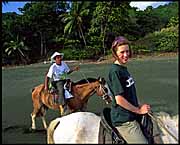 After lunch, we hopped onto a couple of scrawny poky horses with Urbano as our
guide. Chantal hadn't been on a horse for eight years, but she took to her
mount, whom she dubbed "Matthew" because that was as close as she could get to
the Spanish name, with gusto.
After lunch, we hopped onto a couple of scrawny poky horses with Urbano as our
guide. Chantal hadn't been on a horse for eight years, but she took to her
mount, whom she dubbed "Matthew" because that was as close as she could get to
the Spanish name, with gusto.
This was right up there with the Tortuguero boats in my book of Great Ways to
see the Rainforest. With the horse handling locomotion and watching the beach
for obstacles, I could look straight up into the almond trees at the scarlet
macaws. I was hot and sweaty but not soaked in perspiration or unable to see
through fogged glasses.
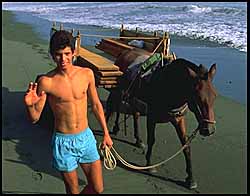 We walked up the beach, into "Downtown Carate" and then up the road toward
Puerto Jiménez. We passed some tiny farms and then climbed up over a
lake. We had to turn around at the gate of an estate. Urbano explained that
it used to be possible to go all the way around the lake and back to the beach,
but a rich gringo had bought the estate, locked the gate, and ruined
everything.
We walked up the beach, into "Downtown Carate" and then up the road toward
Puerto Jiménez. We passed some tiny farms and then climbed up over a
lake. We had to turn around at the gate of an estate. Urbano explained that
it used to be possible to go all the way around the lake and back to the beach,
but a rich gringo had bought the estate, locked the gate, and ruined
everything.
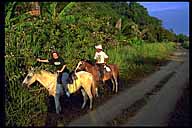 On the way back, Urbano spotted some spider monkeys up in the canopy. We
pushed the horses into the forest a bit and looked up while one of the monkeys
looked down at us. The most bizarre incident was when one monkey got chased
out of the canopy by his fellows and stood in the road looking back into the
forest. We watched him for awhile then started back while a couple of Costa
Rican kids ran out to look at the monkey. One of them picked up some gravel,
presumably to throw at him.
On the way back, Urbano spotted some spider monkeys up in the canopy. We
pushed the horses into the forest a bit and looked up while one of the monkeys
looked down at us. The most bizarre incident was when one monkey got chased
out of the canopy by his fellows and stood in the road looking back into the
forest. We watched him for awhile then started back while a couple of Costa
Rican kids ran out to look at the monkey. One of them picked up some gravel,
presumably to throw at him.
We rode back along the beach as a beautiful sunset developed over the Pacific.
A communal fish dinner awaited at the tent camp, which we shared with Jeffrey's
Treetops Explorations staff and two Dutch women, Ati and Manon. I asked
Jeffrey what was the toughest part about living in the jungle for months.
"I'm kind of a phone and email junkie so when I go back to San Jose, which is
about once every month, I run up a huge phone bill. Then there are the little
inconveniences of living in the tropics, such as the Bot Fly."
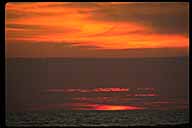 Bot Fly?
Bot Fly?
"The Bot Fly somehow gets its eggs onto the stingers of insects like
mosquitoes. When you get bitten by the mosquito, the Bot Fly eggs are inserted
under your skin and they hatch into little white worms, about an inch long and
fat. The worms start moving around, eating your flesh, and tunneling up to the
surface for air. It is the most incredibly painful thing you've ever
experienced."
Had he ever gotten bitten?
"My girlfriend and I went camping out of Sirena [in the middle of Corcovado
National Park] and it was very hot so we slept without much covers. I later
discovered that I had three Bot Fly worms living in my ass."
What did he do?
"The native remedy is to put a strip of bacon over the worms, which you can see
right through your skin. The Bot Fly needs air so it tunnels up through the
bacon and you just peel the bacon off when this happens and goodbye Bot Flies.
Unfortunately, in my case only two of the three worms came through and the
third one died under my skin. I got a nasty infected boil and I had to go to a
doctor in San Jose to have it removed."
How much did it cost?
"I didn't have to pay for it, but it probably would have been about $50. It
only took about half an hour. My girlfriend was back in Boston by the time she
discovered her bites. We talked about it on the telephone and I told her what
to do. Unfortunately, she used a big sausage instead of bacon and she fell
asleep, which I told her not to do. The Bot Flies came out but then they went
back in after they'd had their air. She ended up going to Beth Israel hospital
where they had no idea what to do. They called every tropical disease
specialist in the country and when they were through, summoned every intern and
doctor in the hospital to watch the extraction. They even videotaped her rear
end while they removed the Bot Flies. It took eight and a half hours and cost
thousands of dollars."
Sunday, January 21, 1995
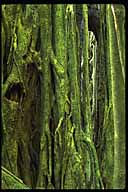 Corcovado serves a 5:30 breakfast for people crazy enough to take the
morning Treetop Explorations tour. At 6 a.m. we met with Jeffrey, Oswaldo, a
bearded Costa Rican, and Taylor, a young New York/San Francisco outdoors type.
We had to sign a liability waiver before leaving. This freed Treetop
Explorations from responsibility even if they were negligent and tried to make
sure that any litigation happened in Costa Rica rather than the U.S."
Corcovado serves a 5:30 breakfast for people crazy enough to take the
morning Treetop Explorations tour. At 6 a.m. we met with Jeffrey, Oswaldo, a
bearded Costa Rican, and Taylor, a young New York/San Francisco outdoors type.
We had to sign a liability waiver before leaving. This freed Treetop
Explorations from responsibility even if they were negligent and tried to make
sure that any litigation happened in Costa Rica rather than the U.S."
"We have some assets in the United States that we'd like to protect," Jeffrey
explained, "though we are insured to the hilt."
We started walking up to the platform.
"The hardest part of the tour is the hike up," Jeffrey had said. He wasn't
kidding. Even at 6:45 a.m., Corcovado is hot and humid enough to make walking
up the mountainside tough. I was wearing my photo vest stuffed with lenses and
sweat soaked all of my clothing within minutes.
"We're walking through secondary forest right now," Jeffrey said, "and it turns
out that secondary forest may actually support some species of birds better
than primary forest. A lot more research needs to be done before we disdain
secondary forest."
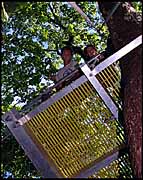 How much of Costa Rica was primary forest?
How much of Costa Rica was primary forest?
"It was 85% in 1964. Now it is down to 26% and about 22% of the country is
under some form of protection, national parks comprising 8%," Jeffrey
replied.
What has happened to the population in that time?
"It was about two million in 1964 and a little over three million now," Oswaldo
answered. "We have one of the highest population growth rates in the world
because everyone is Catholic, but it is changing."
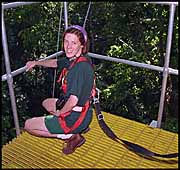 "The main problem is money," Jeffrey said. "The 22% under protection isn't
even safe because not all of the land has been paid for. Costa Rica has about
the highest per capita debt of any country in the world. The banks that made
all of those loans were crazy to think that a country like this could ever pay
them back. The World Bank is the #1 enemy of the Costa Rican rainforest."
"The main problem is money," Jeffrey said. "The 22% under protection isn't
even safe because not all of the land has been paid for. Costa Rica has about
the highest per capita debt of any country in the world. The banks that made
all of those loans were crazy to think that a country like this could ever pay
them back. The World Bank is the #1 enemy of the Costa Rican rainforest."
[I later learned that the debt is about $4 billion, or about $1,200/person.]
Fortunately for me, the Treetops crew stopped every few minutes on the way up
to point out various features of the ecosystem. We admired beautiful Scarlet
Tanagers, small black birds with bright red markings, and studied termite
trails on the underside of tree branches. Butterflies were visible at every
point on the trail, including the beautiful electric blue Morpho. Costa Rica
is home to more than 1500 species of butterflies, more than all of North
America, and most of them seem to be at home in Corcovado.
When we got up to the platform, Jeffrey, Taylor, and Oswaldo began putting
ropes and harnesses together.
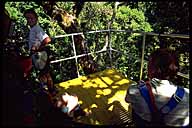 "We thought about building a platform between a couple of trees," Jeffrey said,
"and had all kinds of designs with slip joints but then we talked to a lot of
arborists and ended up just with this one 500-year-old Aho tree. We assembled
it in Berkeley just to make sure that we had all of the pieces. The hardest
thing was getting 3000 lbs. of equipment down here. United Airlines gave us a
break on the air freight, but the day it was scheduled to leave Miami was the
second day of a huge hurricane. The captain just didn't want to take off and I
had to explain to him the importance of the project and how I had people on the
ground in Costa Rica waiting to move it through customs. In the end, we got it
down here on schedule, but it came marked as air freight instead of baggage and
that ruined all of our arrangements. We had to pay an extra $1000 to get it
out."
"We thought about building a platform between a couple of trees," Jeffrey said,
"and had all kinds of designs with slip joints but then we talked to a lot of
arborists and ended up just with this one 500-year-old Aho tree. We assembled
it in Berkeley just to make sure that we had all of the pieces. The hardest
thing was getting 3000 lbs. of equipment down here. United Airlines gave us a
break on the air freight, but the day it was scheduled to leave Miami was the
second day of a huge hurricane. The captain just didn't want to take off and I
had to explain to him the importance of the project and how I had people on the
ground in Costa Rica waiting to move it through customs. In the end, we got it
down here on schedule, but it came marked as air freight instead of baggage and
that ruined all of our arrangements. We had to pay an extra $1000 to get it
out."
In bribes or fees?
"In fees," Jeffrey said. "We'd rather pay a little more money than get into
bribes and encourage that kind of thing."
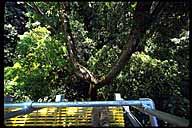 I'd expected the platform to be a wooden tower built in a clearing in the
forest, but that obviously isn't in the best spirit of conservation. Instead,
we looked up to find a grid of yellow fiberglass-epoxy surrounded by leafy
branches. A couple of ropes hung down.
I'd expected the platform to be a wooden tower built in a clearing in the
forest, but that obviously isn't in the best spirit of conservation. Instead,
we looked up to find a grid of yellow fiberglass-epoxy surrounded by leafy
branches. A couple of ropes hung down.
"We're just putting this harness on you as a belay," Oswaldo explained, "it
won't be used at all if the sling works properly."
How many people have ended up hanging from their body harness?
"None," Jeffrey laughed.
[They'd been operating since December 10, i.e., for a little over a month.]
Some combination of whistles, radio, and winching was used to hoist me up about
130 feet in a minute or two. I concentrated on looking at the trees and
branches at eye level.
When I arrived at the platform, Jeffrey hitched my harness onto a "monkey's
tail" bolted to the tree, then unhitched me from the belay.
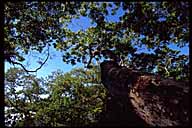
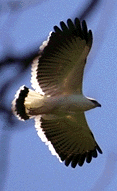 I'd expected to see a lot more wildlife up here in the canopy than I'd seen
from the ground; I didn't. We did see quite a few spider monkeys at our level
and fairly close, also circling white hawks, feeding hummingbirds, tree
squirrels, vultures, and lots of "little birds" that the naturalists had no
trouble identifying. Being up in the canopy was its own reward, however, and
even if we'd seen no wildlife it would have been worth it.
I'd expected to see a lot more wildlife up here in the canopy than I'd seen
from the ground; I didn't. We did see quite a few spider monkeys at our level
and fairly close, also circling white hawks, feeding hummingbirds, tree
squirrels, vultures, and lots of "little birds" that the naturalists had no
trouble identifying. Being up in the canopy was its own reward, however, and
even if we'd seen no wildlife it would have been worth it.
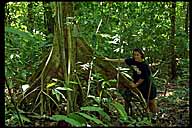 Chantal stands next to a "walking tree," which actually can move several meters/year. Two second exposure.
Chantal stands next to a "walking tree," which actually can move several meters/year. Two second exposure.
Corcovado Tent Camp has no hot water and I was damn glad for that when we got
back around 11:30. After standing under a cold shower for 15 minutes, I felt
sufficiently civilized to go in for lunch, take a few photographs, then hang
out in the hammocks by our tent.
Nature seemed to be saying "stay in the camp.... stay in the camp...." for she
sent us five spider monkeys and several pairs of the magnificent scarlet
macaws. We could see them from right in front of our tent so there was no
reason on earth to leave the hotel. Chantal wanted to go on the Rio Madrigal
hike, which other guests had raved about.
"If you're already tired, I wouldn't go," Lana cautioned a middle-aged
Iranian-American. "It's kind of a difficult trail."
I didn't feel all that tired, but I should have taken her advice because a
"difficult trail" in Costa Rica generally means no trail at all.
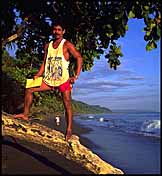 Felipe wore a perpetual smile, no shoes, and the kind of ropy muscles that one
gets from 28 years of living in this area. He took us up the mountain first
via a dry creek bed, then straight up a dry slippery hillside. We walked about
150 feet across a slope that featured a sharp drop-off to the left, steadying
ourselves on tree trunks. It didn't seem as though we were gaining all that
much altitude, but my heart pounded and sweat poured off my face in rivers. I
was sufficiently out of it that I never noticed where I dropped my prescription
sunglasses.
Felipe wore a perpetual smile, no shoes, and the kind of ropy muscles that one
gets from 28 years of living in this area. He took us up the mountain first
via a dry creek bed, then straight up a dry slippery hillside. We walked about
150 feet across a slope that featured a sharp drop-off to the left, steadying
ourselves on tree trunks. It didn't seem as though we were gaining all that
much altitude, but my heart pounded and sweat poured off my face in rivers. I
was sufficiently out of it that I never noticed where I dropped my prescription
sunglasses.
[My sunglasses came back via courier about a month later; Felipe had
found them. Three months later, a friendly Bostonian smashed a window
in my minivan and took my backpack containing both sunglasses and
Samantha, my PowerBook 170 on which this entire travelogue was written.]
Felipe led us down a wet stream to the Rio Madrigal for a swim. The water was
a cool 76 degrees and I immersed myself up to my face, but didn't get cool. In
fact, sweat was still pouring out of my face even as I sat in the water. I
didn't want to get out, but it was 4:30 and sunset was fast approaching.
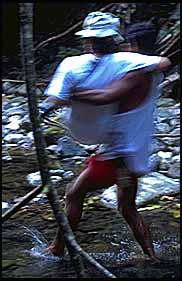 Walking down the river wasn't so bad. Thanks to Felipe's encyclopedic
knowledge of the area, we saw several Jesus Christ lizards skipping over the
water, observed a crayfish that he dug up, and ate some Hibiscus flowers that
tasted like watermelon.
Walking down the river wasn't so bad. Thanks to Felipe's encyclopedic
knowledge of the area, we saw several Jesus Christ lizards skipping over the
water, observed a crayfish that he dug up, and ate some Hibiscus flowers that
tasted like watermelon.
 It was nearly sunset when we got down to the beach, but Felipe's energy was
undimmed. He scaled a coconut tree and brought down a bunch, then hacked them
open with the huge knife he carried on his hip so that we could drink the
milk.
It was nearly sunset when we got down to the beach, but Felipe's energy was
undimmed. He scaled a coconut tree and brought down a bunch, then hacked them
open with the huge knife he carried on his hip so that we could drink the
milk.
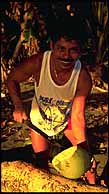
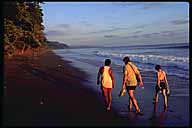 We still had to walk a little more than a mile back to the tent camp. Just
putting one foot in front of the other on the soft sand took all my energy. I
had a tough time admiring the sunset, the macaws, or the spider monkeys we saw
from the beach. I spent the evening under cold showers, drinking, and
generally feeling weak with a resting pulse of 90.
We still had to walk a little more than a mile back to the tent camp. Just
putting one foot in front of the other on the soft sand took all my energy. I
had a tough time admiring the sunset, the macaws, or the spider monkeys we saw
from the beach. I spent the evening under cold showers, drinking, and
generally feeling weak with a resting pulse of 90.
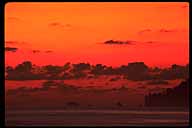 [I later developed a theory about why Corcovado seemed so oppressively hot.
Washington, D.C., where I grew up, actually records higher temperatures and
similar humidity. Yet I don't remember ever getting this enervated after
exercise there. I've concluded that it is much easier to tolerate a few hours
of heat and humidity if you spend the rest of the day and night air
conditioned. My body seems to have a long time constant. I don't mind the
cold in Massachusetts because I'm never out in it for more than a few hours.
The coldest weeks of my life were in Israel where they are too poor to heat
houses or restaurants. Being at 45 degrees 24 hours/day felt much colder than
being at 15 degrees for part of the day and 72 degrees the rest of the time.]
[I later developed a theory about why Corcovado seemed so oppressively hot.
Washington, D.C., where I grew up, actually records higher temperatures and
similar humidity. Yet I don't remember ever getting this enervated after
exercise there. I've concluded that it is much easier to tolerate a few hours
of heat and humidity if you spend the rest of the day and night air
conditioned. My body seems to have a long time constant. I don't mind the
cold in Massachusetts because I'm never out in it for more than a few hours.
The coldest weeks of my life were in Israel where they are too poor to heat
houses or restaurants. Being at 45 degrees 24 hours/day felt much colder than
being at 15 degrees for part of the day and 72 degrees the rest of the time.]
Monday, January 23, 1995
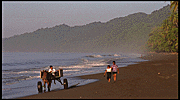
 After a 6 a.m. breakfast, which was yet another in a series of
remarkably good meals considering the remoteness of the tent camp and the
reasonable prices, six of us walked up the beach to Carate. The sun was in our
faces and we were all sweating by the time we got to the airstrip. Early light
on the Pacific was beautiful though and flocks of pelicans entertained us by
fishing right on top of the breakers.
After a 6 a.m. breakfast, which was yet another in a series of
remarkably good meals considering the remoteness of the tent camp and the
reasonable prices, six of us walked up the beach to Carate. The sun was in our
faces and we were all sweating by the time we got to the airstrip. Early light
on the Pacific was beautiful though and flocks of pelicans entertained us by
fishing right on top of the breakers.
 Ken, an artist from Seattle, shouted just after we took off.
Ken, an artist from Seattle, shouted just after we took off.
"Look at those turtle tracks!" Ken pointed down at the beach. Spotting turtles
nesting at night was just one of the popular Corcovado activities that we'd
failed to try. This was Chantal's favorite place in all of Costa Rica and she
was very sorry to leave after such a short time; I wasn't personally upset by
the idea of getting into the cool mountains. I would have liked to go out to
Caño Island, a famous spot for its snorkeling, turtle-watching, and
pre-Columbian cemetery, but there is currently no way to get there from Carate;
you have to start in Drake's Bay, the main tourist town in the area, which is
on the other side of the national park.
 Continue on to Monteverde
Continue on to Monteverde
philg@mit.edu
Related Links
Add a comment | Add a link
 We flew out of Tortuguero in the morning in a Cessna 180 that looked
decidedly old and downmarket after the Piper Twin. The flight was beautiful
and this time I "checked" the yellow river that Edgar had mentioned. We also
saw the highway that we'd taken on the way back from rafting the Pacuare.
Costa Rica is one rugged country and the only way to fully appreciate it is
from the air. We changed planes in San Jose and picked up another
single-engine Cessna for the flight to Carate. We climbed away from the local
airport, over shantytowns and estates, then coffee plantations, and then
stripped hillsides with cabins. The Central Valley has many charms, but not
much wilderness remains.
We flew out of Tortuguero in the morning in a Cessna 180 that looked
decidedly old and downmarket after the Piper Twin. The flight was beautiful
and this time I "checked" the yellow river that Edgar had mentioned. We also
saw the highway that we'd taken on the way back from rafting the Pacuare.
Costa Rica is one rugged country and the only way to fully appreciate it is
from the air. We changed planes in San Jose and picked up another
single-engine Cessna for the flight to Carate. We climbed away from the local
airport, over shantytowns and estates, then coffee plantations, and then
stripped hillsides with cabins. The Central Valley has many charms, but not
much wilderness remains.


 Downtown Carate proved to be a pulperia next to the airstrip. The
nearest telephone is in Puerto Jiménez, a 90 minute drive around the
coast over a dirt road.
Downtown Carate proved to be a pulperia next to the airstrip. The
nearest telephone is in Puerto Jiménez, a 90 minute drive around the
coast over a dirt road.





 After lunch, we hopped onto a couple of scrawny poky horses with Urbano as our
guide. Chantal hadn't been on a horse for eight years, but she took to her
mount, whom she dubbed "Matthew" because that was as close as she could get to
the Spanish name, with gusto.
After lunch, we hopped onto a couple of scrawny poky horses with Urbano as our
guide. Chantal hadn't been on a horse for eight years, but she took to her
mount, whom she dubbed "Matthew" because that was as close as she could get to
the Spanish name, with gusto.









 Chantal stands next to a "walking tree," which actually can move several meters/year. Two second exposure.
Chantal stands next to a "walking tree," which actually can move several meters/year. Two second exposure.




 We still had to walk a little more than a mile back to the tent camp. Just
putting one foot in front of the other on the soft sand took all my energy. I
had a tough time admiring the sunset, the macaws, or the spider monkeys we saw
from the beach. I spent the evening under cold showers, drinking, and
generally feeling weak with a resting pulse of 90.
We still had to walk a little more than a mile back to the tent camp. Just
putting one foot in front of the other on the soft sand took all my energy. I
had a tough time admiring the sunset, the macaws, or the spider monkeys we saw
from the beach. I spent the evening under cold showers, drinking, and
generally feeling weak with a resting pulse of 90.


